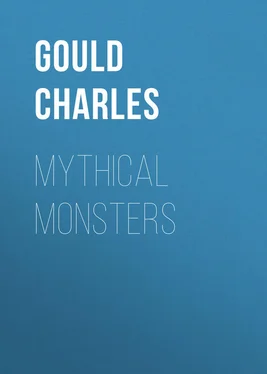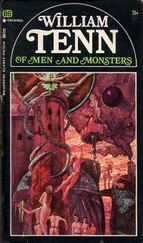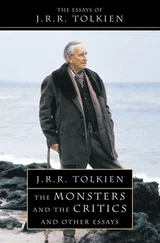Charles Gould - Mythical Monsters
Здесь есть возможность читать онлайн «Charles Gould - Mythical Monsters» — ознакомительный отрывок электронной книги совершенно бесплатно, а после прочтения отрывка купить полную версию. В некоторых случаях можно слушать аудио, скачать через торрент в формате fb2 и присутствует краткое содержание. Жанр: Мифы. Легенды. Эпос, Природа и животные, foreign_antique, foreign_prose, на английском языке. Описание произведения, (предисловие) а так же отзывы посетителей доступны на портале библиотеки ЛибКат.
- Название:Mythical Monsters
- Автор:
- Жанр:
- Год:неизвестен
- ISBN:нет данных
- Рейтинг книги:5 / 5. Голосов: 1
-
Избранное:Добавить в избранное
- Отзывы:
-
Ваша оценка:
- 100
- 1
- 2
- 3
- 4
- 5
Mythical Monsters: краткое содержание, описание и аннотация
Предлагаем к чтению аннотацию, описание, краткое содержание или предисловие (зависит от того, что написал сам автор книги «Mythical Monsters»). Если вы не нашли необходимую информацию о книге — напишите в комментариях, мы постараемся отыскать её.
Mythical Monsters — читать онлайн ознакомительный отрывок
Ниже представлен текст книги, разбитый по страницам. Система сохранения места последней прочитанной страницы, позволяет с удобством читать онлайн бесплатно книгу «Mythical Monsters», без необходимости каждый раз заново искать на чём Вы остановились. Поставьте закладку, и сможете в любой момент перейти на страницу, на которой закончили чтение.
Интервал:
Закладка:
Another equally striking instance is given by my late father, Mr. J. Gould, in his work on the humming-birds. Of two species, inhabiting respectively the adjacent mountains of Pichincha and Chimborazo at certain elevations, each is strictly confined to its own mountain; and, if my memory serves me correctly, he mentions similar instances of species peculiar to different peaks of the Andes.
Limitation by insular isolation is intelligible, especially in the case of mammals and reptiles, and of birds possessing but small power of flight; and we are, therefore, not surprised to find Mr. Gosse indicating, among other examples, that even the smallest of the Antilles has each a fauna of its own, while the humming-birds, some of the parrots, cuckoos, and pigeons, and many of the smaller birds are peculiar to Jamaica. He states still further, that in the latter instance many of the animals are not distributed over the whole island, but confined to a single small district.
Continental limitation is effected by mountain barriers. Thus, according to Mr. Wallace, almost all the mammalia, birds, and insects on one side of the Andes and Rocky Mountains are distinct in species from those on the other; while a similar difference, but smaller in degree, exists with reference to regions adjacent to the Alps and Pyrenees.
Climate, broad rivers, seas, oceans, forests, and even large desert wastes, like the Sahara or the great desert of Gobi, also act more or less effectively as girdles which confine species within certain limits.
Dependence on each other or on supplies of appropriate food also form minor yet practical factors in the sum of limitation; and a curious example of the first is given by Dr. Van Lennep with reference to the small migratory birds that are unable to perform the flight of three hundred and fifty miles across the Mediterranean. He states that these are carried across on the backs of cranes. 39
In the autumn many flocks of cranes may be seen coming from the North, with the first cold blast from that quarter, flying low, and uttering a peculiar cry, as if of alarm, as they circle over the cultivated plains. Little birds of every species may be seen flying up to them, while the twittering cries of those already comfortably settled upon their backs may be distinctly heard. On their return in the spring they fly high, apparently considering that their little passengers can easily find their way down to the earth.
The question of food-supply is involved in the more extended subject of geological structure, as controlling the flora and the insect life dependent on it. As an example we may cite the disappearance of the capercailzie from Denmark with the decay of the pine forests abundant during late Tertiary periods.
Collision, direct or indirect, with inimical species often has a fatal ending. Thus the dodo was exterminated by the swine which the early visitors introduced to the Mauritius and permitted to run wild there; while the indigenous insects, mollusca, and perhaps some of the birds of St. Helena, disappeared as soon as the introduction of goats caused the destruction of the whole flora of forest trees.
The Tsetse fly extirpates all horses, dogs, and cattle, from certain districts of South Africa, and a representative species in Paraguay is equally fatal to new-born cattle and horses.
Mr. Darwin 40shows that the struggle is more severe between species of the same genus, when they come into competition with each other, than between species of distinct genera. Thus one species of swallow has recently expelled another from part of the United States; and the missel-thrush has driven the song-thrush from part of Scotland. In Australia the imported hive-bee is rapidly exterminating the small stingless native bee, and similar cases might be found in any number.
Mr. Wallace, in quoting Mr. Darwin as to these facts, points the conclusion that “any slight change, therefore, of physical geography or of climate, which allows allied species hitherto inhabiting distinct areas to come into contact, will often lead to the extermination of one of them.”
It is the province of the palæontologist to enumerate the many remarkable forms which have passed away since man’s first appearance upon the globe, and to trace their fluctuations over both hemispheres as determined by the advance and retreat of glacial conditions, and by the protean forms assumed by past and existing continents under oscillations of elevation and depression. Many interesting points, such as the dates of the successive separation of Ireland and Great Britain from the main continent, can be determined with accuracy from the record furnished by the fossil remains of animals of those times; and many interesting associations of animals with man at various dates, in our present island home and in other countries, have been traced by the discovery of their remains in connection with his, in bone deposits in caverns and elsewhere.
Conversely, most valuable deductions are drawn by the zoologist from the review which he is enabled to take, through the connected labours of his colleagues in all departments, of the distinct life regions now mapped out upon the face of the globe. These, after the application of the necessary corrections for various disturbing or controlling influences referred to above, afford proof reaching far back into past periods, of successive alterations in the disposition of continents and oceans, and of connections long since obliterated between distant lands.
The palæontologist reasons from the past to the present, the zoologist from the present to the past; and their mutual labours explain the evolution of existing forms, and the causes of the disparity or connection between those at present characterizing the different portions of the surface of the globe.
The palæontologist, for example, traces the descent of the horse, which, until its reintroduction by the Spaniards was unknown in the New World, through a variety of intermediate forms, to the genus Orohippus occurring in Eocene deposits in Utah and Wyoming. This animal was no larger than a fox, and possessed four separated toes in front, and three behind. Domestic cattle he refers to the Bos primigenius, and many existing Carnivora to Tertiary forms such as the cave-bear, cave-lion, sabre-tiger, and the like.
The zoologist groups the existing fauna into distinct provinces, and demands, in explanation of the anomalies which these exhibit, the reconstruction of large areas, of which only small outlying districts remain at the present date, in many instances widely separated by oceans, though once forming parts of the same continent; and so, for the simile readily suggests itself, the workers in another branch of science, Philology, argue from words and roots scattered like fossils through the various dialects of very distant countries, a mutual descent from a common Aryan language: the language of a race of which no historical record exists, though in regard to its habits, customs, and distribution much may be affirmed from the large collection of word specimens stored in philological museums.
Thus Mr. Sclater, on zoological grounds, claims the late existence of a continent which he calls Lemuria, extending from Madagascar to Ceylon and Sumatra; and for similar reasons Mr. Wallace extends the Australia of Tertiary periods to New Guinea and the Solomon Islands, and perhaps to Fiji, and from its marsupial types infers a connection with the northern continent during the Secondary period.
Again, the connection of Europe with North Africa during a late geological period is inferred by many zoologists from the number of identical species of mammalia inhabiting the opposite sides of the Mediterranean, and palæontologists confirm this by the discovery of the remains of elephants in cave-deposits in Malta, and of hippopotami in Gibraltar; while hydrographers furnish the supplemental suggestive evidence that an elevation of only fifteen hundred feet would be sufficient to establish two broad connections between the two continents – so as to unite Italy with Tripoli and Spain with Morocco, and to convert the Mediterranean Sea into two great lakes, which appears, in fact, to have been its condition during the Pliocene and Post Pliocene periods.
Читать дальшеИнтервал:
Закладка:
Похожие книги на «Mythical Monsters»
Представляем Вашему вниманию похожие книги на «Mythical Monsters» списком для выбора. Мы отобрали схожую по названию и смыслу литературу в надежде предоставить читателям больше вариантов отыскать новые, интересные, ещё непрочитанные произведения.
Обсуждение, отзывы о книге «Mythical Monsters» и просто собственные мнения читателей. Оставьте ваши комментарии, напишите, что Вы думаете о произведении, его смысле или главных героях. Укажите что конкретно понравилось, а что нет, и почему Вы так считаете.











